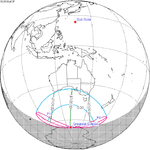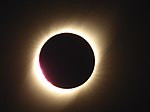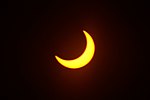Solar eclipse of January 6, 2019
| Solar eclipse of January 6, 2019 | |
|---|---|
 From Nakhodka, Russia | |
| Type of eclipse | |
| Nature | Partial |
| Gamma | 1.1417 |
| Magnitude | 0.7145 |
| Maximum eclipse | |
| Coordinates | 67°24′N 153°36′E / 67.4°N 153.6°E |
| Times (UTC) | |
| Greatest eclipse | 1:42:38 |
| References | |
| Saros | 122 (58 of 70) |
| Catalog # (SE5000) | 9550 |
A partial solar eclipse will occur on January 6, 2019. A solar eclipse occurs when the Moon passes between Earth and the Sun, thereby totally or partly obscuring the image of the Sun for a viewer on Earth. A partial solar eclipse occurs in the polar regions of the Earth when the center of the Moon's shadow misses the Earth.
Images
Related eclipses
Solar eclipses of 2018-2021
This eclipse is a member of a semester series. An eclipse in a semester series of solar eclipses repeats approximately every 177 days and 4 hours (a semester) at alternating nodes of the Moon's orbit.[1]
The partial solar eclipses on February 15, 2018 and August 11, 2018 occur in the previous lunar year eclipse set.
| Solar eclipse series sets from 2018 to 2021 | ||||||
|---|---|---|---|---|---|---|
| Ascending node | Descending node | |||||
| Saros | Map | Gamma | Saros | Map | Gamma | |
117 Partial in Melbourne, Australia |
July 13, 2018 Partial |
−1.35423 | 122 Partial in Nakhodka, Russia |
January 6, 2019 Partial |
1.14174 | |
127 Totality in La Serena, Chile |
July 2, 2019 Total |
−0.64656 | 132 Annularity in Jaffna, Sri Lanka |
December 26, 2019 Annular |
0.41351 | |
137 Annularity in Beigang, Yunlin, Taiwan |
June 21, 2020 Annular |
0.12090 | 142 Totality in Gorbea, Chile |
December 14, 2020 Total |
−0.29394 | |
147 Partial in Halifax, Canada |
June 10, 2021 Annular |
0.91516 | 152 From HMS Protector off South Georgia |
December 4, 2021 Total |
−0.95261 | |
Metonic series
The metonic series repeats eclipses every 19 years (6939.69 days), lasting about 5 cycles. Eclipses occur in nearly the same calendar date. In addition, the octon subseries repeats 1/5 of that or every 3.8 years (1387.94 days). All eclipses in this table occur at the Moon's descending node.
| 22 eclipse events between June 1, 2011 and October 24, 2098 | ||||
|---|---|---|---|---|
| May 31–June 1 | March 19–20 | January 5–6 | October 24–25 | August 12–13 |
| 118 | 120 | 122 | 124 | 126 |
 June 1, 2011 |
 March 20, 2015 |
 January 6, 2019 |
 October 25, 2022 |
 August 12, 2026 |
| 128 | 130 | 132 | 134 | 136 |
 June 1, 2030 |
 March 20, 2034 |
 January 5, 2038 |
 October 25, 2041 |
 August 12, 2045 |
| 138 | 140 | 142 | 144 | 146 |
 May 31, 2049 |
 March 20, 2053 |
 January 5, 2057 |
 October 24, 2060 |
 August 12, 2064 |
| 148 | 150 | 152 | 154 | 156 |
 May 31, 2068 |
 March 19, 2072 |
 January 6, 2076 |
 October 24, 2079 |
 August 13, 2083 |
| 158 | 160 | 162 | 164 | |
 June 1, 2087 |
 October 24, 2098 | |||
References
- ^ van Gent, R.H. "Solar- and Lunar-Eclipse Predictions from Antiquity to the Present". A Catalogue of Eclipse Cycles. Utrecht University. Retrieved 6 October 2018.
External links





